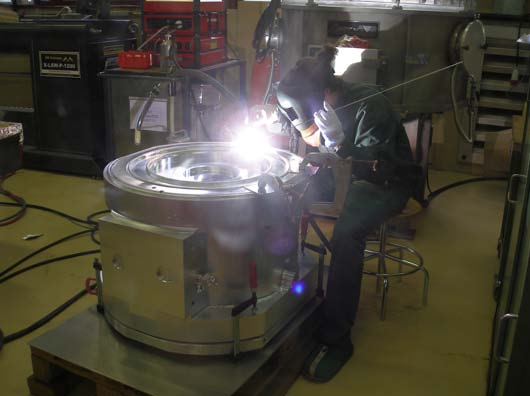The neutrons fly once more
After four years of inactivity at the neutron Time Of Flight (n_TOF) facility neutrons are once again flying as the facility successfully restarts with a new target.
The n_TOF facility was originally opened in November 2000 and enjoyed four years of successful operation, but in 2004 a technical problem was discovered and the facility was closed. Now, after another four years, n_TOF has reopened, achieving the goal of getting some initial results before the winter shutdown.
On 10 November the team successfully started the preliminary phase of the commissioning of the new n_TOF target. After struggling for four hours at low intensity with misaligned quadrupoles, they finally succeeded in getting a good beam centered on the target. Intensity was raised above detection threshold and most of the detectors were triggered as expected, showing events compatible with predictions.
Originally the brainchild of Carlo Rubbia, the n_TOF facility studies the effects of neutrons on matter. A proton beam from the PS strikes a lead target and produces an intense neutron beam via the spallation process. The target is cooled with water, which also acts as a neutron moderator, however in 2004 a problem arose with this cooling system, leading to the facility being closed. The new target, which was installed three weeks ago, is much more complex than its predecessor with a completely new cooling design.
The decision was made to reopen the n_TOF facility in February this year. Since then a motivated team from different departments has been working flat-out to design and build the new target in time to get some initial results before the PS stops on 12 November. "With just 35 weeks from the first brainstorm to having a completed target it was really a challenge," said Paolo Cennini, the technical coordinator. "Not only because of the complexity of the design itself, but also to comply with the radiation protection safety rules which are particularly constraining for this application."
The aim of n_TOF is to measure precisely the neutron cross-section of various radioactive elements. This data has a range of applications, from astrophysics to the transmutation of hazardous radioactive waste into more benign, stable waste forms.
Nuclear transmutation is the change of one element or isotope to another and is a consequence of a nuclear reaction. A radioactive element can transmute naturally to a more stable element through spontaneous decay, but transmutations can also be produced artificially by irradiation with neutrons at the required energy. "If you expose any element to a neutron flux you could produce an effect, but the effect is strongly dependent on the neutron energy," explained Cennini. "So you may have a material that can be transmuted, but only with very precise neutron energy levels".
The neutrons produced by the proton beam impinging the target travel inside the vacuum tube over a distance of 185 m before hitting the sample under measurement. The long flight path gives rise to a time spectrum dependent on the neutron kinetic energy allowing for very high energy resolution.
The facility is capable of producing a dense flux of neutrons over a huge energy range, from 1 eV to 1 GeV, with a good energy resolution over the entire energy spectrum. This characteristic is of primary importance to provide data for the evaluation of the neutron cross-sections. n_TOF is one of the best facilities in the world capable of performing with such high energy resolution and intensity over such a large energy range.
The n_TOF collaboration is already preparing new proposals for future measurements expected in 2009, as soon as the facility is fully operational.


